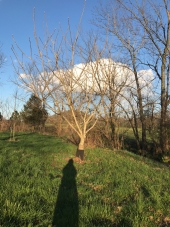








Bethanny Parker wrote:so it may just be that the squirrels have dragged them home.
Moderator, Treatment Free Beekeepers group on Facebook.
https://www.facebook.com/groups/treatmentfreebeekeepers/













To be truly radical is to make hope possible, rather than despair convincing. - Raymond Williams




John Elliott wrote:I'm going to go out on a limb here and suggest that maybe your soil can be improved by digging in a lot of limestone or marble chips. Besides improving the drainage, it will add a lot of calcium to the soil and harden the water. Calcium does help to break up clay, that's why gypsum is a recommended amendment for clay soils. Black walnuts really do well in the Ozarks, and that area is thin soil on top of lots and lots of limestone. If you can trench a foot deep along the drip line and backfill it with limestone or marble chips, I'll bet you would see an improvement.





For unlimited return on all your investments - Make your deposits at 'The Entangled Bank' !




wayne stephen wrote:Bethanny , How close are your trees to other trees ? Walnut trees that grow close to other hardwood trees - as in a forest - will grow straight trunked with little canopy . These trees have far less nut production than far spaced walnuts which have a full spread and low branches.





Afghani Nurmat wrote:Hi there,
maybe a bit off-topic, but how is calcium going to break up clay? don`t want to wiseguy or something; i`m just interested because my soil is based on limestone and under the two inches of topsoil there is a massive layer of minimum one foot clay/loam. would be so happy to find an alternative to digging up tons of clay to make growbeds for rootcrops (which i love).





For unlimited return on all your investments - Make your deposits at 'The Entangled Bank' !




wayne stephen wrote:Bethanny , Those 50ft tall straight trunked walnut trees are the most valuable lumber trees in North America . No reason to worry about the nuts .




Bethanny Parker wrote: Is there a reason for doing it at the dripline as opposed to closer to the tree? Sorry if it's a dumb question: On the scale of permaculture knowledge, even though I've been trying to soak up all the knowledge I can for months, I still feel like I'm pretty close to "newbie."










Success has a Thousand Fathers , Failure is an Orphan
LOOK AT THE " SIMILAR THREADS " BELOW !
 1
1




 1
1




Vic Johanson
"I must Create a System, or be enslaved by another Man's"--William Blake







 1
1




"...specialization is for insects." - Lazarus Long
Universal Introduction to Permies
How Permies.com works
 1
1













|
Climb the rope! CLIMB THE ROPE! You too tiny ad:
The new gardening playing cards kickstarter is now live!
https://www.kickstarter.com/projects/paulwheaton/garden-cards
|







